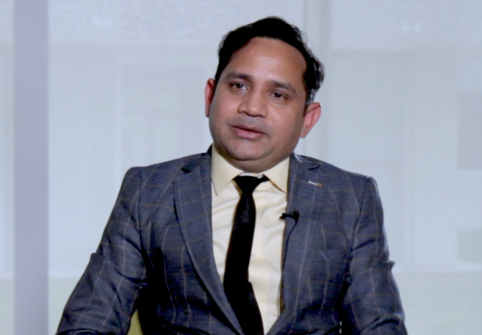Q-and-A How Can We Stay Physically Active During COVID-19?
Dr. Nathan Townsend
Why is it important to stay physically active as the COVID-19 situation unfolds? How can the general population do so?
Regular physical activity leads to improved health and overall wellbeing. The benefits of regular moderate (brisk walking) to vigorous (jogging or running) physical activity are widespread and include a decreased risk of cardiovascular disease, stroke, hypertension, Type II diabetes, obesity, cancer, and chronic obstructive pulmonary disease. Regular physical activity has also been shown to be beneficial in treating mental illnesses such as clinical depression. In fact, physical inactivity is one of the strongest risk factors associated with the worsening of these chronic illnesses, and poses an increased risk for otherwise healthy individuals developing such illnesses later in life. It is therefore important that people maintain regular exercise to prevent the onset of chronic illness or lessen the detrimental effects.
As the COVID-19 situation unfolds, these recommendations become more crucial because the current data on the virus clearly shows that individuals with underlying chronic health issues are most at risk. Therefore, it is advisable for people to maintain good health during the pandemic.
Given that public fitness centers are closed, there are two main ways that the general public can maintain regular physical activity: through at home exercise or outdoors while practicing social distancing.
Do you think that the closure of gyms, spas, parks and sports clubs should prevent or deter the general population from exercising? Why or why not?
Definitely not. As noted, at home exercise is an option and exercising outdoors (where permissible) is also a good option.
Are there specific exercises that can help boost the immune system and thus enable us to become less susceptible to the virus?
To answer this question, it is important to first understand that there are two types of immunity: innate immunity and acquired immunity. Innate immunity refers to non-specific defense mechanisms that help us to fight a variety of pathogens including viruses, bacteria, and protozoa. Acquired immunity refers to the development of anti-bodies (immunoglobins) which act like a sort of molecular “memory” to a specific pathogen. Acquired immunity is only developed by exposure to the specific pathogen or by obtaining a vaccine.
It should be noted that SARS-cov2 (the virus which causes COVID-19) is a “novel” virus. This means that no humans have developed an acquired immunity to this virus previously. Therefore, exercise alone will not lead to acquired immunity to this specific virus. However, regular exercise is well-known to enhance the function of the innate immune system. What this means is that exercise per se cannot prevent a person from becoming infected if they are exposed to SARS-cov2, but it will assist the person in fighting the COVID-19 infection and lessen the severity of the illness.
Although no specific exercises enhance the innate immune system, maintaining consistent moderate to vigorous aerobic activity is key: 150 min per week is recommended, which equates to four 40-minute brisk walks per week.
Are there specific exercises that can help boost the performance of the respiratory system?
Moderate to vigorous aerobic exercise is the best form of exercise to boost performance of the respiratory system. This form of exercise has been shown to improve respiratory muscle strength and endurance, lung diffusing capacity, and effective airflow through the large airways and small airways.
Reducing or stopping smoking may be even more beneficial for improving respiratory health than exercise alone. Quitting smoking and maintaining regular exercise is highly recommended.
How can exercise contribute to boosting the mental health of community members during COVID-19?
Regular physical activity improves mental health in a number of ways. In particular, exercise is known to counteract the detrimental health effects of psychological stress. During this period, many people are psychologically “stressed” due to fears relating to their own personal safety, financial security, and uncertainty about the future. This type of stress activates the “hypothalamic- pituitary-adrenal” (HPA) axis, which acts to convert psychologically stressful emotions into physiological changes in the body that are detrimental to one’s health. However, regular exercise is proven to counteract the activation of HPA axis and thus oppose the overall stress response due to mental anxiety.
Additionally, there is also strong evidence that suggests regular exercise is beneficial for those with clinical depression and post-traumatic stress disorder. The mechanism of effect is complex but may involve improvements to the central nervous system neurotransmitter function including the dopaminergic system and beta-endorphins.
What are some easy and useful exercises that can be performed at home?
In the absence of any specific exercise equipment, the best form of home-based exercise programs are “bodyweight” exercises, dance, and yoga.
Bodyweight exercises include things like squats and single leg squats, push-ups, lying glute raises and leg lifts, core exercise such as planks/bridges, star jumps, burpees, walking lunges, and even running on the spot.
With minimal equipment, exercise such as skipping or stepping can be done. Even items such as books, bottles of water, or canned food can be used as substitutes for weights.
Dancing is a great form of exercise that is fun and easy, but it has to be vigorous dancing that gets the heart rate up.
Yoga is also an excellent form of home exercise that is both strengthening and aerobically challenging.
There are many home-based workout programs on YouTube. A quick search for “indoor workout”, “bodyweight exercise ideas”, “home workout”, and “home yoga” brings up thousands of workouts varying in intensity and duration.
What are the most suitable intervals and frequencies when it comes to exercising?
Basic guidelines for the minimum amount of exercise that should be conducted: 20 minutes of minimum continuous exercise within a single session 3 times per week (but anything, even one day per week, is better than nothing). Increase the heart rate and breathing.
The intensity should feel the equivalent of brisk walking and be sure to maintain consistency within a workout. For example, try to maintain an elevated heart rate and breathing for 20 continuous minutes at a time before taking a rest or a break.
Individuals with advanced fitness levels can practice “high intensity interval training” (HIIT). This form of exercise involves shorter periods (2-10 min) of higher intensity exercise interspersed with recovery breaks. The heart rate and breathing are elevated higher and a sensation of physical discomfort should arise, which eventually will lead to the need to stop or slow down. There are many forms of HIIT but a simple/basic starting point is to conduct the following: warm-up for 10 minutes (easy exercise), followed by two minutes of hard or very hard intensity activities, and then 2-3 minutes of easy or recovery exercises. Repeat 4-6 times then cool down for 5-10 minutes.
Do you have any recommendations to ensure the hygiene, health and safety of people as they exercise during this period?
Adhere more strictly to social distancing guidelines whilst exercising, especially if you are going outdoors for a walk or a run. Stay well clear of other people while you are exercising because of the higher breathing rate. It is also important to stay well-hydrated as the warmer weather approaches, and avoid exercising outdoors during the hottest hours of the day.




